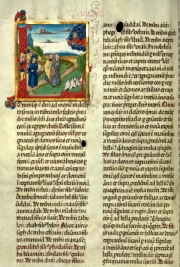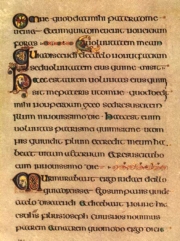 I’ve been on the offensive with a series of posts on the historicity of the New Testament. In conversations with Christians, however, I’ve been asked variations of this: “Okay, smart guy: you make clear that you don’t want to interpret the gospel story as literally true. Enlighten us then—how do you explain the facts? What do you think happened?”
I’ve been on the offensive with a series of posts on the historicity of the New Testament. In conversations with Christians, however, I’ve been asked variations of this: “Okay, smart guy: you make clear that you don’t want to interpret the gospel story as literally true. Enlighten us then—how do you explain the facts? What do you think happened?”
That’s a fair question, and I’m happy to make a claim and defend it. Even if you accept my contention that the Bible is just legend and that the supernatural stuff didn’t happen—that it’s the surviving fragments of the blog of a prescientific tribe of people who lived two to three thousand years ago—that only tells us what didn’t happen.
So what did happen? That the New Testament exists is undeniable; what explains it? Here we go.
1. Jesus lived. The Christ Myth Theory, which argues there is insufficient evidence for a historical Jesus, is another possibility, but the simplest argument seems to be that a real man grounded the Jesus story. It’s easy to imagine false legend being built on a foundation of an actual person in history.
2. Jesus was an influential rabbi who had a following. He was killed, and stories grew up about him after he died.
3. The stories were passed from person to person orally for decades, eventually touching thousands or tens of thousands of people. The religion spread quickly by evangelism and trade through the Ancient Near East, from Palestine to Egypt, Syria, Asia Minor, Greece, Italy, and beyond.
4. The stories were corrupted as they went. Some of this might have been inadvertent, but some was deliberate. Embellishments were added to improve the story, either to satisfy imagined or real prophecy from the Old Testament (for a Jewish audience) or to duplicate a supernatural feature of a competing Greek, Mesopotamian, or Egyptian religion (for a gentile audience). Starting from a Jewish community that spoke Aramaic, it found a home in a far-flung community that was culturally Greek.
5. Christianity relied initially on oral history. After decades, when it became clear that the imminent second coming wasn’t coming, the apocalyptic element of the religion was toned down, the religion settled in for the long haul, and the stories were committed to parchment. A handful of these gospels were written in the first century, including the four that made it into the New Testament. Dozens more were added in the following centuries.
6. Some of these later gospels were benign, but others were dangerously incompatible. A Christian community that accepted one tradition might consider another community heretical, and vice versa. Church fathers wrote books against particular heresies: Irenaeus wrote against Gnosticism, Tertullian against Marcionism, and Origen against Platonism. Different philosophies were debated, and the collection of dogmas that we think of today as orthodox Christianity was hardly the obvious winner.
- In opposition to Paul, the Ebionites saw Jesus as preaching an extension of Judaism, not a new religion. Paul himself documents this internal disagreement in the debate over circumcision (Gal. 6:12–13).
- Other heresies fragmented the church before the Council of Nicaea—Montanism (an early kind of Pentecostalism), Nicolationism (hedonism), Antinomianism (an extreme view of salvation through faith alone), Sabellianism (Jesus and God the Father were not distinct persons but two aspects of one person), Doceticism (Jesus was only spirit, and his humanness was an illusion), Arianism (Jesus didn’t always exist but was a created being), rejection of Trinitarianism (God exists in three persons), and others. But of course these were heresies only from the standpoint of the church that eventually emerged victorious.
7. The gospels and epistles were copied over the years and modified in small and large ways to adapt to different communities’ beliefs.
8. What we think of as the official Christian canon of books was largely fixed at the Council of Nicaea in 325.
Point out anything that doesn’t fit, but this sketch best explains the facts as far as I can tell. It is far more plausible than accepting the gospel stories as history.
Read the first post in this series: What Did the Original Books of the Bible Say?
The word “belief” is a difficult thing for me.
I don’t believe. I must have a reason for a certain hypothesis.
[If] I know a thing, then I know it.
I don’t need to believe it.
— Carl Jung
Photo credit: fradaveccs

 We’re taking a trip through time, from our English New Testament, back through the translations and various copies (
We’re taking a trip through time, from our English New Testament, back through the translations and various copies (
 There are two primary places in the New Testament where homosexuality is a condemned practice.
There are two primary places in the New Testament where homosexuality is a condemned practice.